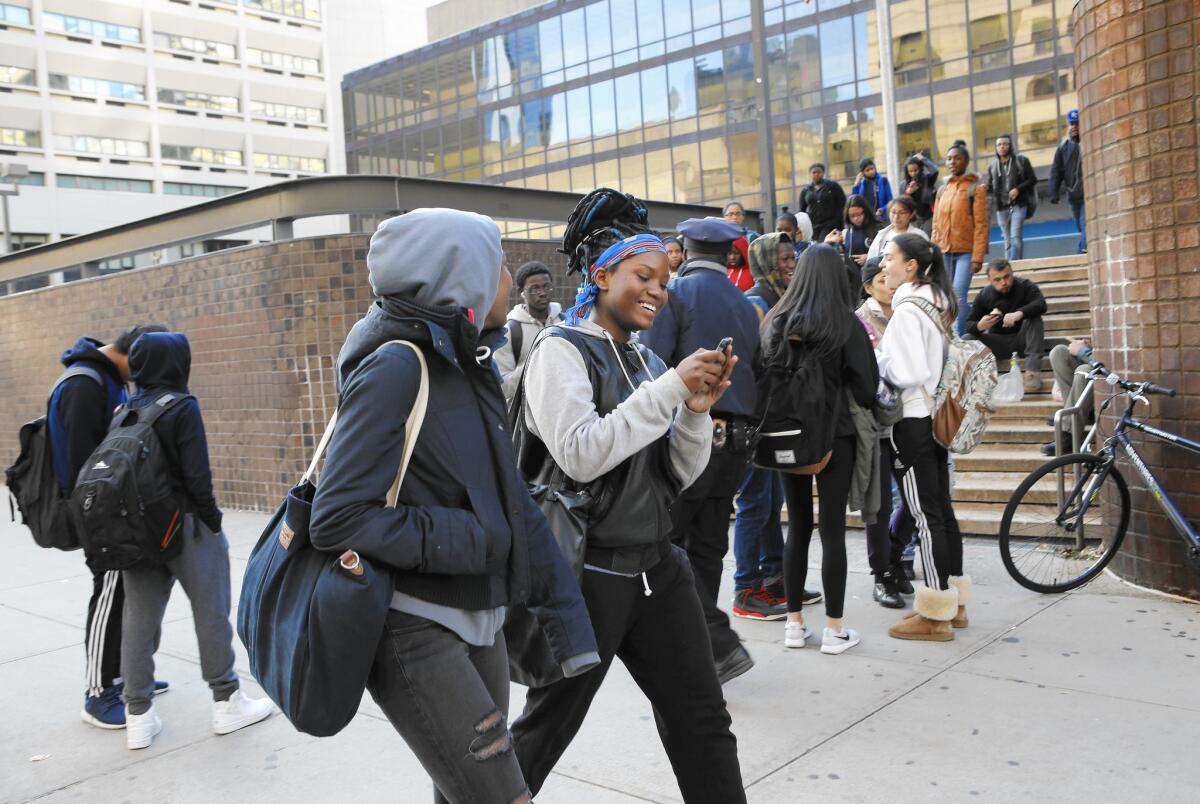New York City’s schools debate removing metal detectors

Reporting from NEW YORK — A student has not been shot in a New York City school in 13 years, a heartening statistic in an era of commonplace school massacres. But there is a growing cry to rid the city’s schools of metal detectors, the very tool some observers credit with keeping them safe.
Some parent groups and advocates say the scanners installed at the city’s most troubled institutions more than two decades ago are now unneeded because of low crime rates, and they condemn them as discriminatory, since by and large they sit in schools serving minority neighborhoods.
“Making students have to go through metal detectors to go to school sends a terrible message to students about where they are headed and how they are viewed,” said Donna Lieberman, executive director of the New York City Civil Liberties Union.
But other parents, and the union for school safety agents in the nation’s largest district, which educates 1.1 million students, warn removing the machines would leave children unsafe. The union that represents the 4,915 school safety officers — who are overseen by the police department but are not armed — stress that scanners placed by the New York Police Department in high-crime schools are necessary.
“It’s very simple: If the scanners are taken away, then every day will be less safe for the students, faculty and school safety agents inside these schools,” said Gregory Floyd, president of Teamsters Local 237. More than 300 weapons, including knives and BB guns, have been recovered by school safety agents since July, Floyd said.
Nearly 90,000 high school students are scanned every day. Some parent groups and education activists have appealed to Mayor Bill de Blasio to eliminate or reduce the use of metal detectors, noting almost half of black students are scanned daily, while only 14% of white students are.
As crime has plunged citywide over the last two decades, the number of violent crimes and robberies in schools has also fallen. Assaults dropped 34% from 2010-2011 to 2014-2015, according to police. Critics of detectors say that drop makes them unnecessary.
A panel convened by City Hall comprising criminal justice and education experts recommended this year that some detectors be removed. A Manhattan education council urged their elimination, and several online petitions support the cause.
But education officials say there are currently no plans for substantive changes.
“While we have taken important steps in the right direction, keeping our schools safe remains our top priority, particularly for our black and Hispanic students and our students with special needs,” said Lois Herrera, head of the district’s student safety program. “We are working tirelessly toward that end.”
Other major cities, such as Los Angeles and Philadelphia, also use scanners in at least some schools. Despite some pushback from civil liberties groups, some cities have doubled down. In Detroit, the first U.S. city to use them, their installation is required for every new and renovated school.
There have been 160 school shootings since 20 children and six adults were killed at Sandy Hook Elementary School in December 2012, according to statistics kept by Everytown for Gun Safety, a gun control advocacy group.
But the last time a student was fatally shot in a New York City school was a double killing in Brooklyn in 1992, police said. After that, metal detectors, previously used just for special events, were put into wider use. And the last shooting overall in the system, which educates 1.1 million students, was on Jan. 12, 2002, according to the NYPD.
That day, 17-year-old Vincent Rodriguez pulled a .380-caliber handgun from his waistband and opened fire in a hallway at Martin Luther King Jr. High School on Manhattan’s Upper West Side. He shot two teenagers in the back after they had teased his girlfriend and pulled a bandanna off her head, police said. Both survived.
These days, it’s one of 88 New York City school buildings — many of which house more than one school — that have metal detectors and safety agents at the watch each morning. Students put items from their pockets into their backpack, which is sent through an X-ray machine. The students step through a metal detector and, if needed, could also undergo a pat-down and wanding.
“I think it’s necessary to keep us safe,” said Cid Morales, a 15-year-old ninth-grader, as he entered school there Monday. School shootings elsewhere, he said, have him “afraid that will happen here.”
But Tajae Dennis, a 16-year-old 10th-grader who also attends a school in the MLK complex, said the scanners make “me feel like I’m going in a prison.”
Lemire writes for the Associated Press.
More to Read
Sign up for Essential California
The most important California stories and recommendations in your inbox every morning.
You may occasionally receive promotional content from the Los Angeles Times.










